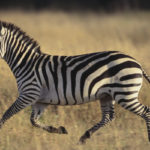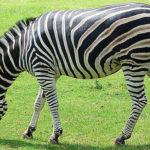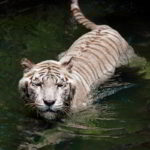What color is a zebra ?
 The peculiar coloring of zebras is conditioned by adaptation to life in the African savannah. The white-black strip provides a disguise from bothersome insects, which tolerate various diseases, bother and interfere with normal livelihoods of animals. Flies and tsetse flies see a continuous ripple instead of zebras, not perceiving them as their prey.
The peculiar coloring of zebras is conditioned by adaptation to life in the African savannah. The white-black strip provides a disguise from bothersome insects, which tolerate various diseases, bother and interfere with normal livelihoods of animals. Flies and tsetse flies see a continuous ripple instead of zebras, not perceiving them as their prey.
In addition, when the animals run off at a gallop from predators, they completely merge with arid savannah and among themselves into a monotonous dark mass, discouraging the beast.
When zebras graze during the day, their striped coloring is lost in vegetation between light and shadow spots, and the specific location of the bands does not allow predators to determine the contour of the animal. In the daytime it is difficult to discern the solipeds from a distance of 200-300 m, and at night they are not visible at a distance up to 40 m.
Contrary to the view of most people, zebras have white stripes on a dark background. At birth, the young have a dark color, and over time, in specific places (genetically determined) the cover loses pigmentation, which gives the appearance of banding. Each zebra has a unique pattern, this sign is akin to the fingerprints of people. These animals easily recognize each other, and even the youngsters follow their mother, focusing on the individual coloring.



























